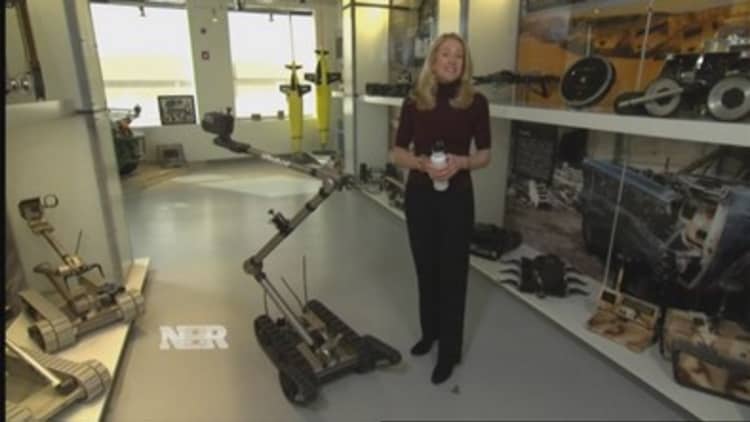In late 2013, two former University of Tokyo professors entered their humanoid robot into a competition sponsored by the U.S. Defense Advanced Research Projects Agency (DARPA). After completing a series of rescue challenges—piloting a vehicle and climbing up a ladder, among them—the SCHAFT S-One robot easily took first place in the inaugural DARPA Robotics Challenge trials.
It could be argued, however, that SCHAFT's big victory came months earlier, when search technology giant Google acquired SCHAFT, not to mention a handful of other robotics companies, for an undisclosed amount. Two months ago Google entered a partnership with Johnson & Johnson subsidiary Ethicon to begin developing surgical robots that one day will work side by side with doctors in the operating room.
Other large, U.S.-based technology companies have also recently been putting more of their money into robotics. In 2012, Amazon spent more than $700 million to acquire Kiva Systems, which makes a mobile robot for carting items sitting on shelves over to packers working inside Amazon fulfillment centers. In 2013, Apple announced it was investing more than $10 billion in supply-chain robots.
While interesting developments on their own, taken together these moves represent a galvanizing moment for the U.S. robotics industry. According to the International Federation of Robotics, the worldwide market for industrial robotics systems is worth $29 billion.
About 235,000 robots are already in use inside U.S. factories, placing the U.S. second to Japan in robot use, according to May numbers from the Robotic Industries Association (RIA). Advances in technology are making robots less expensive, pulling them out of the military and medical realms and pushing them into smaller and medium-size companies, private tech firms and even the consumer market. For years Japan has dominated the robotics industry.
Read MoreRobots: The new low-cost worker
Now the U.S. and a handful of other players, including South Korea and China—today the largest robot market in terms of annual sales—are looking to own corners of an exponentially growing field.
"The most important thing about the robotics industry—now it's starting to see this global understanding that robots can help companies of all sizes in every industry," said Jeff Burnstein, president of the RIA. "That's really exciting, and that's what's going to drive the future here."
Where the U.S. stands to take the lead in the robotics industry is inside the factory.Henrik ChristensenKUKA chair of robotics at the Georgia Institute of Technology
Globally, Japan is still the leader in industrial robotics, according to Burnstein. But an aging population, coupled with a growing need for in-home service robots, will shift the focus of Japan's robotics industry over the next decade, and health-care robotics in Japan will likely overtake industrial uses. Early leaders are already developing products. There's Panasonic, with its Resyone robotic wheelchair bed, and Asratec, with its humanoid ASRA C1.
"The products coming out of Japan in the last 10 years have been targeted at the aging population," said Henrik Christensen, the KUKA chair of robotics at the Georgia Institute of Technology. "I don't think we're going to see as many humanoid robots in the U.S. in the short term. … Japan is way ahead of us."
Where the U.S. stands to take the lead in the robotics industry is inside the factory, Christensen said, in part because the salaries of workers in places where the U.S. has traditionally outsourced are now going up.
"Over the last 10 years, salaries in China have gone up by 350 percent," he said. "So if we're looking at 10 years ago, it was very hard to compete with manual labor in China. Over the same period, [U.S.] salaries have gone up less than 10 percent. … So it makes sense to manufacture more in the U.S. than 10 years ago."
Get ready for the robotics revolution
While robots have been a staple of the American automotive industry for decades, the big push in the U.S. now is on collaborative robots. The National Robotics Initiative, launched by the Obama administration in 2011, has spent about $300 million in new robotics research and development that's "been very focused on robots working with humans," Christensen said. Picture the factory of the future, where a robot named Baxter stands ready to complete the day's tasks. He has two arms with multiple axes of rotation, just like a human's arms, and 360-degree sonar capabilities.
"Collaborative robots is a place where we've got a significant opportunity," said Jim Lawton, chief product officer at Rethink Robotics, the Boston-based manufacturer of the Baxter robot. "Most of the technology that's required to be able to build this next wave of robotics exists in the U.S." Lawton said the U.S. holds an advantage when it comes to robots with advanced vision capabilities and anticipatory artificial intelligence.
Read MoreWorld's angriest robot: Checking in on your company sometime soon?
"We've been doing robotics for years, but everything's starting to line up," said Ayanna Howard, a professor in the Institute for Robotics and Intelligent Machines at Georgia Tech. "Computing is amazing. The actuations, electronics and motors that you need to make robots function in the real world are getting cheaper. Everything's kind of coming together."

Whether these developments on the home front represent any type of race globally is a matter of debate. Christensen said that for companies in need of the venture capital to build a robotics company, "the U.S. is the best." Lawton argues that the drivers of manufacturing and competitiveness will be robotics.
Read MoreWhy you shouldn't fear the robot revolution—yet
"There's a land grab now for who's going to own the home, who's going to own the factory," he said. "One of the strategies is robots are the vehicles to do that. I don't think we can afford to sit on the sidelines of this."
Japan, as it has felt the heat of other competitors in the global market, has certainly taken moves to redouble its efforts for the coming robotics revolution. As Reuters reported in the fall, the government is planning regulatory reforms that are aimed at tripling Japan's robotics market to $21 billion by 2020.
But the pie seems to be big enough for multiple countries to take a bite of, even as a company like Google—which declined an interview for this article—spends hundreds of millions buying up multiple robotics start-ups.
"It shouldn't be seen as a competition between two countries," said Martial Hebert, director of the Robotics Institute at Carnegie Mellon University. "Some opportunities will be taken by some countries, others by other countries. … But it's a really exciting time."
—By Andrew Zaleski, special to CNBC.com




